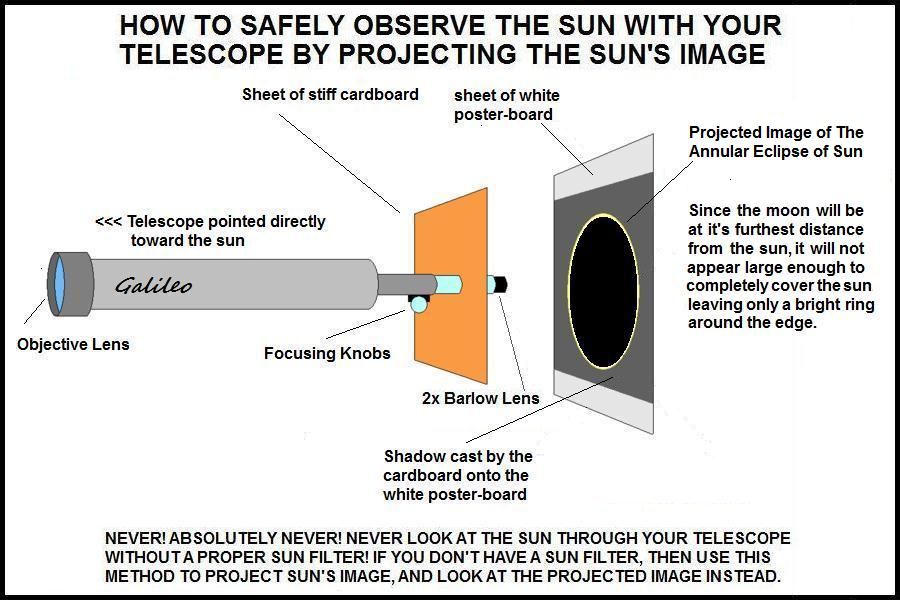
An annular eclipse is almost like a total eclipse, except the moon will not appear large enough to completely cover the sun, so, a bright ring will appear around the edge. Annular is derived from the Latin word "Annulus" for ring.

The moon appears approximately the same size as the sun, sometimes slightly smaller, and sometime slightly larger. This is because the moon revolves in an elliptical orbit around the earth, having an average distance of 238,857 miles from the earth, with the closest distance being 225,622 miles and the furthest distance being 252,088 miles.
The moon's diameter is 2,160 miles while the sun's diameter is 865,000 miles, and it's distance is about 93,000,000 miles. While the sun and moon appear about the same size, the sun's diameter is actually 400 times as great as the moon's diameter, but it's also 400 times as far away as the moon, so, that is why the sun and moon appear about the same size.
When the moon is at it's closest distance from us when passing in front of the sun, it will appear slightly larger than the sun, so, it will completely cover the sun, causing a total eclipse.
But, when the moon is at it's farthest distance from us when passing in front of the sun, it will appear slightly smaller then the sun, so, it will not completely cover the sun, thus, leaving a bright ring around the edge, causing only an annular eclipse.
And, that is what I will be seeing here in El Paso Texas on Sunday, May 20,2012 before sun set.
Now, it is perfectly safe to look up at a total eclipse of the sun when the sun is completely covered by the moon, but it is not safe to look at a partial eclipse or even annular eclipse, because even the thin ring around the edge is enough to cause damage to your eyes without proper eye protection.
So, if you're going to use a telescope, you need a good sun filter, either the small one that screws onto the eyepiece, which I don't recommend because the light from the sun focuses on the filter and the heat might cause the filter to crack. I don't think they even make eyepiece filter anymore.
It's better to have a large sun filter that covers the objective lens in front of the telescope, but the larger the objective lens, the larger the filter you will require, and the more it costs. Sun filters cost anywhere from $50 to $300 dollars depending on the size.
My Galileo brand telescope has a 60 mm objective lens with a 900 mm focal length.

This is what my telescope looks like.
But, if you don't have a sun filter, then the best, and absolute safest method, is to remove the eyepiece, and insert either a 2x or 3x Barlow lens, and project the sun's image onto a sheet of white poster-board, and just look at the projected image, as depicted in my picture below.

Yeah! I know, this is not drawn to scale. So, sue me!
This is the safest method. First, you get a sheet of stiff cardboard, put a hole in the center slightly smaller then the diameter of the focusing tube for a nice snug fit. The sheet of cardboard will cast a shadow on the ground where you'll have the sheet of white poster-board. The further away the sheet of poster-board is held from the Barlow lens, the larger the sun's image will appear, so, you can get a nice big image about 6 to 12 inches across, and you turn the focusing knobs until you get a sharp image. You can even see the sun spots before the moon finally covers the sun, and since this is going to be an annular eclipse, you will see the ring of light projected on the poster-board.
This is the absolute safest method to observe the sun with your telescope, because you don't actually look through the telescope, but only at the projected image on the white poster-board.
Anyway, I'm looking forward to seeing the annular eclipse this coming Sunday, May 20,2012 from 6:33 PM until until sunset at 7:58 PM.
 I'm fat and sassy! I love to sing & dance & stomp my feet & really rock your world!
I'm fat and sassy! I love to sing & dance & stomp my feet & really rock your world!
